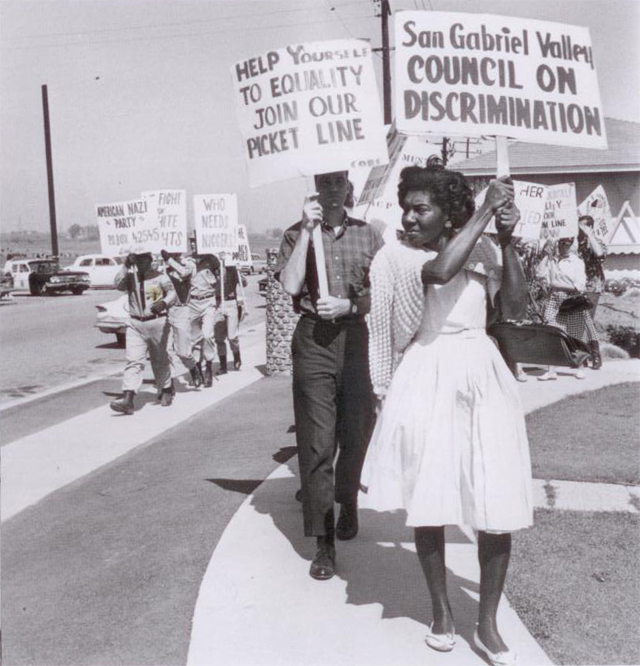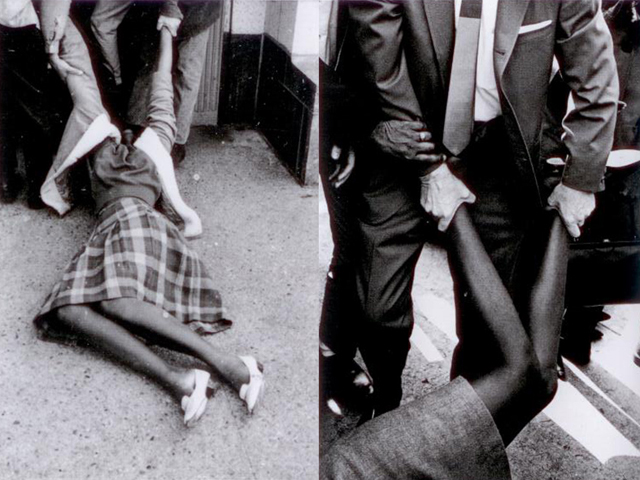Wisconsin historian and UWM grad Mark Speltz has brought Badger State history alive in books like "Bottoms Up: A Toast to Wisconsin’s Historic Bars and Breweries" and "Fill ‘er Up: The Glory Days of Wisconsin Gas Stations," and via his work as a historian for Madison-based American Girl.
But he's also worked to tell the story of Civil Rights here, via articles and exhibitions featuring Father James Groppi and others. His latest book, "North of Dixie: Civil Rights Photography Beyond the South," is a hard-hitting photographic look at the fight for civil rights, via work by Bob Adelman, Ruth-Marion Baruch, Charles Brittin, Diana Davies, Jack Delano, Leonard Freed, Don Hogan Charles, Gordon Parks, Art Shay, Morgan and Marvin Smith, and Maria Varela.
There are images of protests and of confrontation, including images from Milwaukee. It is a powerful, powerful collection.
As Speltz prepares to return to Milwaukee nex week for a free event on Tuesday, Feb. 7 at 6 p.m. at Milwaukee Public Library's Washington Park branch, 2121 N. Sherman Blvd., we asked him to select his favorite images from "North of Dixie" and tell us what about them moves him most.

GOLDMAN AND PARRISH, CHICAGO, 1946. Chicago History Museum.
Protesters demonstrating against racial discrimination at the White City Roller Rink, 63rd
and South Parkway (later King Drive).
"Taken just after World War II, this photograph shows how black veterans that fought for freedom and democracy abroad endured a second class citizenship in America. Chicago veterans and CORE activists picketed outside a roller skating rink, aptly named White City, that would not allow blacks to skate there."

CHARLES BRITTIN, NEAR LOS ANGELES, CA, 1963. Los Angeles, Getty Research Institute.
Activists picketing at a demonstration for housing equality while uniformed American Nazi Party members
counterprotest in the background with signs displaying anti-integration slogans and racist epithets.
"Resistance to civil rights protests was not uncommon in the North. Members of the American Nazi Party counter-demonstrate efforts to end discrimination at a greater Los Angeles housing tract that would not accept African American residents. Nazis and members of the Ku Klux Klan turned up at protests in Milwaukee in the 1960s, too."

COX STUDIO, SAN FRANCISCO, CA, 1955. Washington, DC, Library of Congress, Prints and Photographs
Division, Visual Materials from the NAACP Records.
San Francisco NAACP members during a Don’t Ride campaign urging riders to boycott Yellow Cab
and help stop hiring discrimination.
"I happened across this compelling picture at the Library of Congress while cranking through reels of microfilmed photographs in the massive NAACP collections. I am repeatedly struck by the impeccably dressed demonstrators – note the ladies’ white gloves – picketing the Yellow Cab Company over hiring discrimination."

DECLAN HAUN, CHICAGO, IL, 1966. Chicago History Museum.
Chicagoans young and old blatantly expressing their distaste for open housing.
"Crowds lined Chicago streets during the summer of 1966 as Dr. King and the Chicago Freedom Movement called attention to housing discrimination, slum conditions, and gross inequalities in the public school system blacks faced. Declan Haun beautifully captured this young girl's reaction."

BOB ADELMAN, BROOKLYN, NY, 1963. Courtesy Bob Adelman.
A woman blocking dump trucks, slowing construction through civil disobedience as part of a protracted
battle against unfair hiring practices at the Downstate Medical Center. Brooklyn.
"Images of female activists—like this well-dressed woman kneeling on a protest sign at an urban construction site – are rarely considered iconic. The most circulated photographs tend to emphasize politicians, charismatic male leaders, and nonviolent protesters being brutally attacked in the American South. But to me, this photograph by Bob Adelman is everything. Ordinary Americans built, conceived of, and waged local civil rights campaigns from L.A. to Harlem and coast to coast."

"Unknown Photographer, Milwaukee, WI, December 1966 © 2015 Journal-Sentinel, Inc.
Member of Milwaukee NAACP Youth Council mopping floor of the group’s Freedom House. The many
photographs and news clippings pinned to the bulletin board behind him illustrate the young activists’ combined
ability to generate press coverage and call attention to pressing concerns.
This unpublished Milwaukee news photograph makes clear that local NAACP Youth Council members understood their determined actions and civil rights campaigns attracted media coverage and brought attention to issues plaguing the city’s African American residents. Taken in December 1966, the bulletin board is filled with newspaper clippings and photographs related to the group’s efforts to attack racism and end discrimination there earlier that summer."

LEONARD FREED, BROOKLYN, NY, 1963. Los Angeles, the J. Paul Getty Museum, 2008.62.5 /
© Leonard Freed / Magnum Photos.
Demonstrators sitting with signs and intentionally blocking traffic during protest on car-lined thoroughfare.
"Whenever people complain about being inconvenienced by protests or highway closures, I think of this Leonard Freed photograph from Brooklyn. Dr. King and thousands of civil rights activists routinely blocked traffic, marched along highways, and disrupted everyday life to call attention to injustice. Activism is never convenient."

CHARLES BRITTIN, LOS ANGELES, CA, MARCH 10, 1965. Los Angeles, Getty Research Institute.
Protesters being physically removed during a demonstration against the shocking violence in Selma in March 1965.
No clouds of tear gas or swinging clubs are present in these scenes outside the Federal Building in downtown
Los Angeles, but Brittin’s tight focus immediately draws viewers into one of the most dramatic struggles
he documented for CORE.
"Hundreds of protests erupted nationwide in response to the brutal beatings of marchers at the foot of the Edmund Pettus Bridge in Selma, Alabama in 1965. The dramatic arrests and removal of protesters at a Los Angeles demonstration was documented by Charles Brittin, a photographer with the civil rights groups Congress for Racial Equality."

Unknown Photographer, Milwaukee, WI, September 1967. Courtesy Johnson Publishing Company, LLC.
Comedian Dick Gregory (in white hat), Milwaukee NAAC Youth Council adviser Father James Groppi (center),
and Ald. Vel Phillips (right) at a march for open housing. Gregory’s participation generated media coverage locally
and in national publications, including Jet magazine, in which this photograph ran.
"One of my favorite photographs in the whole book, this picture from Jet magazine shows three important participants in Milwaukee’s rich civil rights history – Ald. Vel Phillips, Fr. James Groppi, and comedian, Dick Gregory. The project that turned into 'North of Dixie' got its start in Milwaukee when, as a graduate student, I realized the visual history of critical civil rights campaigns in places like Milwaukee, Cleveland, and Los Angeles needed to be shared with readers. The images in 'North of Dixie' reveal what civil rights looked like up North and beyond Dixie."
Born in Brooklyn, N.Y., where he lived until he was 17, Bobby received his BA-Mass Communications from UWM in 1989 and has lived in Walker's Point, Bay View, Enderis Park, South Milwaukee and on the East Side.
He has published three non-fiction books in Italy – including one about an event in Milwaukee history, which was published in the U.S. in autumn 2010. Four more books, all about Milwaukee, have been published by The History Press.
With his most recent band, The Yell Leaders, Bobby released four LPs and had a songs featured in episodes of TV's "Party of Five" and "Dawson's Creek," and films in Japan, South America and the U.S. The Yell Leaders were named the best unsigned band in their region by VH-1 as part of its Rock Across America 1998 Tour. Most recently, the band contributed tracks to a UK vinyl/CD tribute to the Redskins and collaborated on a track with Italian novelist Enrico Remmert.
He's produced three installments of the "OMCD" series of local music compilations for OnMilwaukee.com and in 2007 produced a CD of Italian music and poetry.
In 2005, he was awarded the City of Asti's (Italy) Journalism Prize for his work focusing on that area. He has also won awards from the Milwaukee Press Club.
He has be heard on 88Nine Radio Milwaukee talking about his "Urban Spelunking" series of stories, in that station's most popular podcast.




